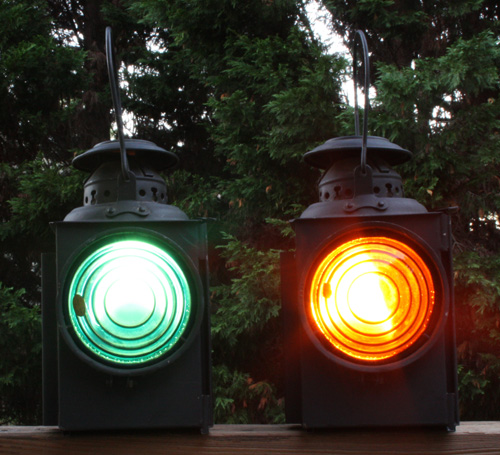
JeffPo's Dressel Slow Order Lamps Page
Last update: 10/19/11

This is a pair of matched order lamps made by the Dressel company. They are referred to as slow order lamps, which will be explained shortly. I also have a Handlan brand slow order lamp. They stand about 10 inches tall (not including the handle). One contains a single yellow/amber lens (which is the actual slow order signal) and the other contains a single green lens (which is the resume speed signal). While the "green" lens looks more like aqua blue, the yellow kerosene flame from the burner will show a signal green color.

Here you can see the rectangular mounting sleeves on the sides of the lamps. You can see a little damage to the tops, with them being squashed a bit, but the lamps are still in excellent shape for their ages and both are still fully functional.

With the sliding doors raised, you can see the fuel founts and burners inside. The doors are stamped with the Dressel company information.

Here you see the lamps fired up. The yellow and green signals certainly get your attention. Wonder how many locomotive engineers gave notice to these particular lamps all those decades ago, when they were in actual use on the railroad? I love having a working piece of historical equipment and I'm mesmerized by the glow of these lamps. The beams of light are like time machines, taking me back to a time of man, steel, and steam, when great smoking locomotives lumbered along the railroad tracks of our country.
Slow Order Lamps

Track workers on the Pennsylvania Railroad.
Slow order lamps were movable track side signals used by railroad working crews. When work crews were scheduled to work on a section of track or bridge, the dispatcher would issue a Train Order for all trains operating on that section of track. The order let the train crew know that they needed to proceed with caution and be prepared to stop as they encountered men and machinery. While the dispatcher knew exactly the starting and stopping points on the section of track that was being worked on, the work crews could be at various points along this section. There could even be multiple crews working along this section of track. The train engineer didn't know exactly where he might encounter the work crews along that section. As an added precaution for safety, a single lens yellow lamp would be placed on a stake driven into the ground beside of the railroad track, one mile before the current location of the work crew. A single lens green signal would be placed at the end of the last work area. This let train engineer know that he could now safely resume speed because there were no other workers ahead of him. As the work crews moved along the section of track during the day, they would move the signal lamps accordingly.
NOTE: Thanks and credit to Red Beard the Railroad Raider for providing information on how these lamps were used.